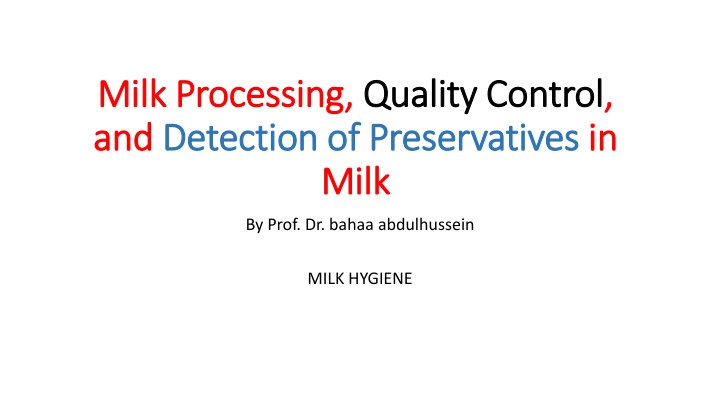
Milk Processing: Quality Control, Detection of Preservatives, and Challenges
Learn about the key steps in milk processing, the importance of quality control tests, methods for detecting preservatives in milk, and challenges faced in the industry. Explore how milk is processed to ensure safety, quality, and compliance with regulations.
Download Presentation

Please find below an Image/Link to download the presentation.
The content on the website is provided AS IS for your information and personal use only. It may not be sold, licensed, or shared on other websites without obtaining consent from the author. If you encounter any issues during the download, it is possible that the publisher has removed the file from their server.
You are allowed to download the files provided on this website for personal or commercial use, subject to the condition that they are used lawfully. All files are the property of their respective owners.
The content on the website is provided AS IS for your information and personal use only. It may not be sold, licensed, or shared on other websites without obtaining consent from the author.
E N D
Presentation Transcript
Milk Processing, Milk Processing, Quality Control and and Detection of Preservatives Detection of Preservatives in Milk Milk Quality Control, , in By Prof. Dr. bahaa abdulhussein MILK HYGIENE
Introduction Introduction to Milk Processing to Milk Processing Overview: Milk processing refers to the series of steps used to convert raw milk into products that are safe, nutritious, and long-lasting. Key Steps in Milk Processing: Reception: Raw milk is collected from dairy farms. Filtration: Milk is filtered to remove any impurities. Pasteurization: Milk is heated to kill harmful bacteria without affecting its nutritional value. Homogenization: The milk is processed to break down fat molecules to create a uniform consistency. Cooling and Storage: The milk is cooled and stored in tanks before being distributed.
Milk Quality Control Tests Milk Quality Control Tests Importance of Quality Control: Ensures that milk meets safety standards and is free from contaminants. Common Tests for Milk Quality: 1. Sensory Evaluation: Checks for color, taste, and odor to ensure freshness. 2. Fat Content Test: Determines the percentage of fat in milk, often using a Gerber method or Babcock test. The Gerber Method is a primary and historic chemical test to determine the fat content of milk and other substances 3. Protein Content Test: Measures the amount of protein in milk, often using the Kjeldahl method. Kjeldahl method is used for the quantitative determination of nitrogen contained in organic substances and the nitrogen contained in inorganic compounds like ammonium, ammonia. 4. Antibiotic Residue Test: Ensures that milk is free from harmful antibiotic residues that may affect human health. 5. pH Level Test: Determines the acidity of milk, which can affect its taste and shelf life. 6. Microbiological Test: Detects harmful bacteria or pathogens (e.g., Salmonella, E. coli).
Detection of Preservatives in Milk Detection of Preservatives in Milk Why Detect Preservatives? Some preservatives may be harmful to human health if used improperly. Detection ensures milk safety and compliance with regulations. Common Preservatives Used in Milk: Sodium Benzoate: Prevents spoilage. Sorbic Acid: Extends shelf life. Formalin (Formaldehyde): Occasionally used illegally to extend freshness. Methods of Detection: 1. Chemical Tests: Titration Method: Used to detect the presence of sodium benzoate or other preservatives. Chromatography (HPLC): Used for precise identification and quantification of preservatives. 2. Spectroscopy: Helps identify preservatives based on their light absorption properties. 3. Enzyme-Linked Immunosorbent Assay (ELISA): Detects specific preservatives based on antigen-antibody reactions.
Challenges in Milk Processing Challenges in Milk Processing Microbial Contamination: Keeping milk free from harmful microorganisms is a major challenge. Preservative Misuse: Illegal or excessive use of preservatives can harm consumers and damage brand reputation. Supply Chain Issues: Maintaining a continuous supply of quality milk and efficient distribution can be difficult. Regulatory Compliance: Ensuring compliance with local and international milk safety standards can be challenging.
Conclusion Conclusion Key Takeaways: Milk processing involves multiple steps to ensure safety and quality. Quality control tests are essential for maintaining the health of consumers. Detection of preservatives in milk is crucial for consumer safety and regulatory compliance. Future Trends: Use of advanced technologies such as sensors, automation, and more accurate detection methods in the milk processing industry.
